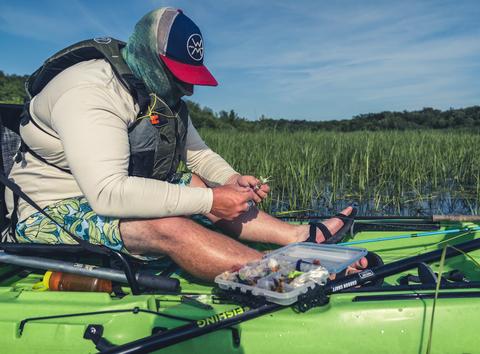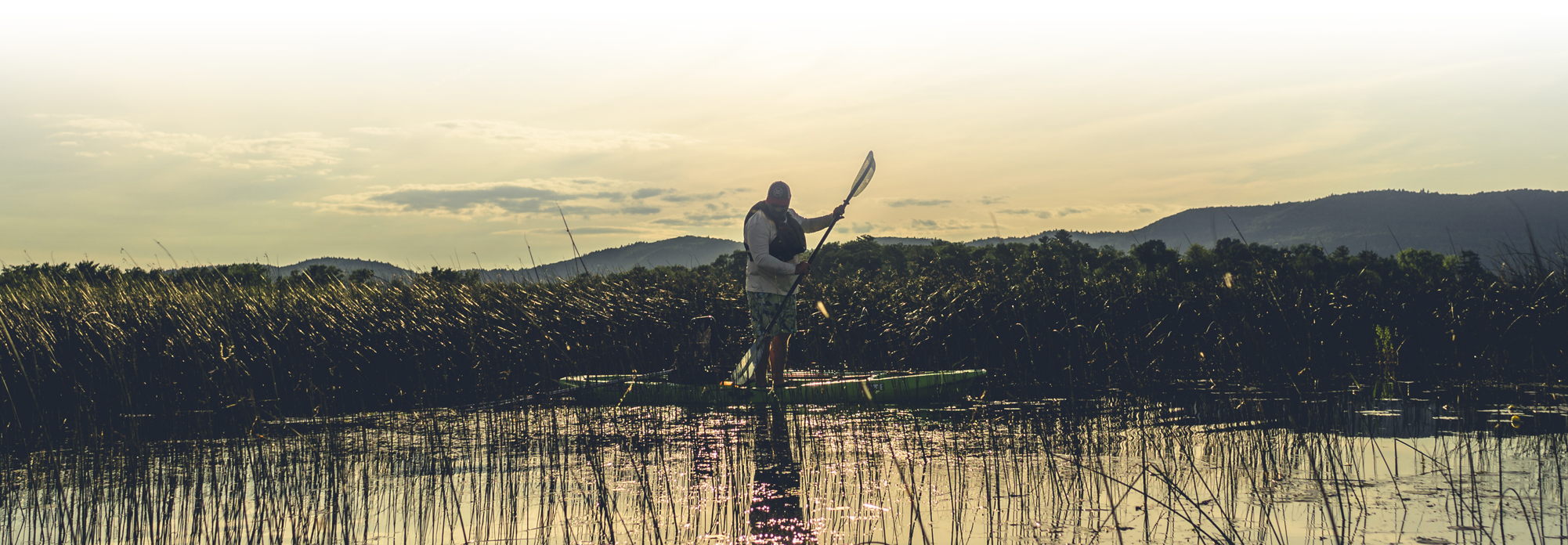Your Cart is Empty
The NEW Bodacious Burst Burst just launched! Go check it out!
The NEW Bodacious Burst Burst just launched! Go check it out!
FLY REELS
Fly Lines
Shop By Fish

How to Fly Fish for Bowfin
August 18, 2021 5 min read

Targeting a prehistoric predator in the sweltering summer sun.
By: Chris Ingram (@chris_ingram802)
It’s the doldrum dog days of summer once the water temps in the rivers have climbed above seventy degrees and even the tribs are running warm, slow, and low. It is much too hot to handle delicate trout and most angling action is limited dusk and dawn. The days are long, hot and humid, but it is not time to hang up the rods and surrender — it’s time to target bowfin. To help shed a little more light on this underappreciated species and what it takes to seal the deal, I’ve linked up on Lake Champlain with fly fishing guide Brian Cadoret of Middlebury, Vermont and co-owner of Stream and Brook Fly Fishing.



📸: : @seanjplatt
Bowfin Biology
It’s not often you hear of fly folks specifically targeting bowfin, but this prehistoric fish species offers some exciting angling prospects. If you’re not familiar with these overlooked, underrated, slimy, stealthy predators, it may be time to take note of their unique physiology, behavior, and aggressive fly-munching temperament.
The bowfin is primitive in appearance, a powerful and muscular machine, with a long, slim, eel-like body boasting an extended top dorsal fin that spans nearly its entire body length — also providing its namesake. Bowfin sport an eyespot near the base of their tails, which may help them confuse predators and escape deadly attacks. These fascinating fish possess the ability to breathe underwater like other fish but are also able to take gulps of air by breaking the surface of the water. As ambush predators, these fish wait quietly in the shadows or slowly stalk through cover before attacking small fish and aquatic invertebrates. They’re known for being extremely elusive while also aggressive.

📸: :@chris_ingram802
When and Where to Locate Bowfin
The best weather and conditions for bowfin fishing are the hot, sunny, clear-sky days with low wind and calm water when fly fishing is far from the minds of many. While mornings and afternoons can offer an additional bump in action, bowfin are generally active all day long, allowing anglers to hit the snooze button or the water after a little family time. In most places, bowfin fishing remains most productive from early spring through late summer.
Bowfin are typically found in the swampy edges, weedy flats, and vegetated portions of freshwater lakes and rivers across most of central and eastern North America. Look for them in sheltered bays and shorelines where pencil reeds, cattails, and lily pads provide ample cover. Thick vegetation creates shadows and structure for the small fish and aquatic critters that bowfin hunt for. Look for inlets and feeder streams where bait fish are often found.
Bowfin Fishing Gear
When rigging up for bowfin, a long, stiff, medium weight rod and a strong leader keeps you on the winning edge to bag a brute bowfin. Brian employs a 9-foot, 10-wt rod with a leader of 40# test monofilament line. His bowfin fly box contains a mix of colorful and drab tones, predominated by crayfish and terrestrial patterns. He uses a stand-on-top kayak to maneuver artfully across areas of vegetative cover, paddle in one hand and fly rod in the other. A massive and seemingly oversized net rests on the stern of the ‘yak, awaiting deployment at a moment’s notice.
Hunting for Bowfin
Unlike blind casting to trout or bass, sight-fishing is the name of the game here. Find water that is not too choppy and not too murky. Utilize polarized sunglasses to increase visibility and peer into the water as you slowly drift across the lilies, searching and scanning for any movement or indication of our quarry. You may glimpse the head of a ‘fin hiding in deep cover or spot the undulating dorsal as a fish sneaks by. Brian twitches his paddle to splash water every few minutes, asserting the curiosity of bowfin is sometimes enough to lure them in. Move your eyes from side to side but don’t forget to look behind your boat as bowfin may be on the move or slow to respond to your splashy siren song. Once a target is acquired, the fly is quickly dropped and danced off the nose of the fish to provoke a long-anticipated strike. This is where you’ll do some experimenting. Some fish want to be teased for a take and others may want you to strip the fly in front of them. Once these tenacious creatures commit, it is a race against the clock to control and contain the fish. They are incredibly strong and agile and will fight their way to entangle themselves in the weeds and muck to evade capture. It takes a swift and nimble angler to emerge victorious form this aggressive, close-quarters combat.

📸: : @chris_ingram802
Bamboozled by Bowfin
Brian and I drift across the bay, awaiting an opportunity to experience bowfin success firsthand. We float over to a small inlet where Brian spots a large shadow lurking in the reeds. He drops his fly and the fish immediately takes the bait with a turbulent eruption of mud and water spewing into the air. With rod bent over and struggling for his footing, Brian deftly reaches for his net while his prized catch surges to avoid capture. The fish dives deep into a wad of cattails, snapping the line and sending the anxious angler abruptly backward, left with a limp rod, a heartfelt sigh, and the enthralling memory of a battle well-fought.
Although we came home empty handed in our quest for our quarry on this particular outing, our thirst for adventure had assuredly been quenched. I leave the lake with an intense sense of awe and wonder for this marvelous fish, and eagerly await my next opportunity to return on the hunt for bowfin.
Back at the boat launch, Brian shares a few epic tales of past bowfin adventures. He remembers a few notable fish as he swipes through his cell phone, showcasing a catalog of memorable captures. I’ll be back. There is no doubt about that, and I look forward to one day landing a prehistoric predator.
So, next time you consider hanging it up or sitting it out when the stagnant summer days hit, why not take a float or walk a river in search of bowfin. You may set out on even the hottest and sunniest days of the year, find a weedy flat or vegetated stretch of water, and have an angling experience unlike any other.
About the Author: Chris Ingram is a talented outdoor photographer and writer.
Cheeky Fishing champions the DIY angler and the waters they fish. Have a tale to tell? Contact us at getcheeky@cheekyfishing.com.






